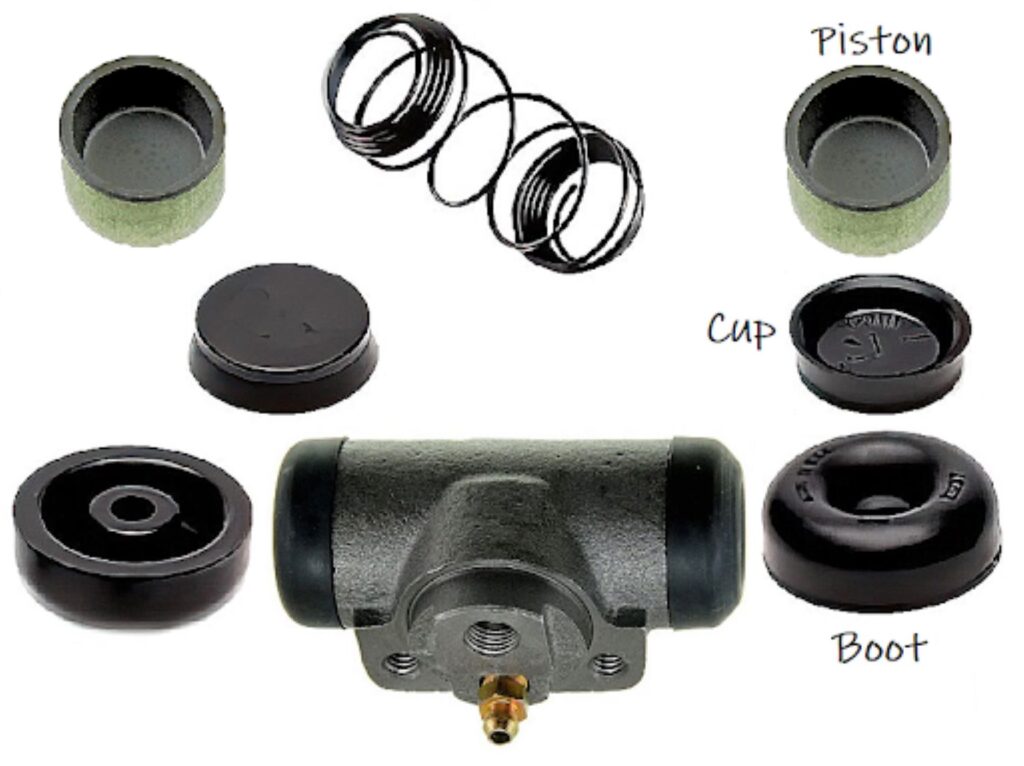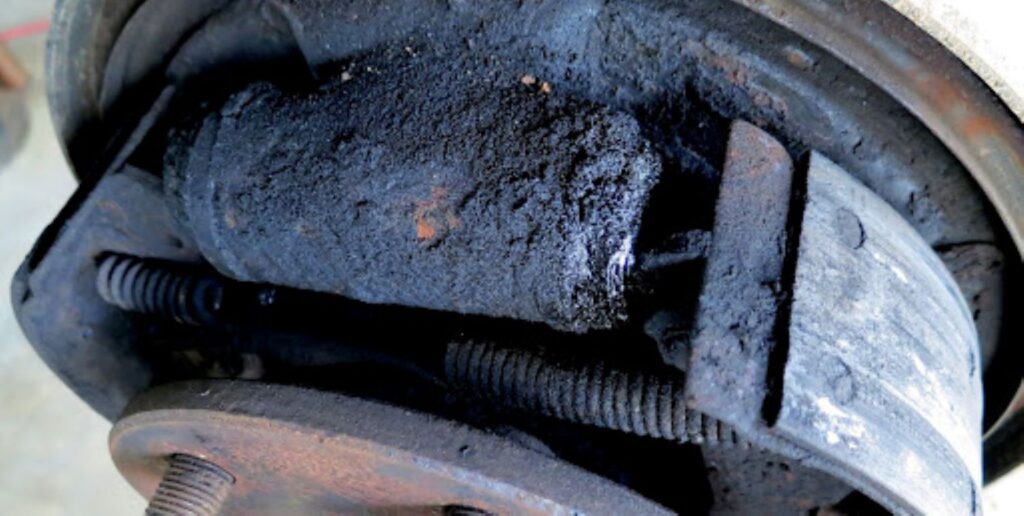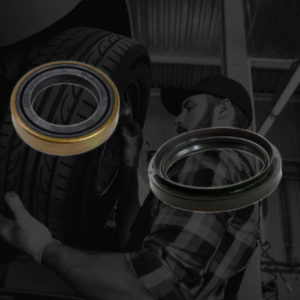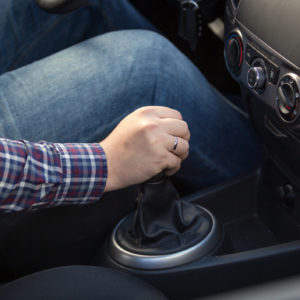Does your car use drum brakes? Its brake wheel cylinders provide the hydraulic pressure to slow down or stop your vehicle. These cylinders take your action of stepping on the brake pedal and convert that into real stopping power.
Brake wheel cylinders wear out like any other car part that sees regular use. Eventually, the cylinders will begin acting up or stop working altogether. Since the wheel cylinders are indispensable in a drum brake system, you must replace them as quickly as possible. Keep an eye out for warning signs like a brake cylinder leaking fluid.
What are Wheel Cylinders?
Brake wheel cylinders are hydraulic devices that engage and disengage the brake shoes. Also called slave cylinders, they rely on the brake master cylinder to supply them with brake fluid.
A brake wheel cylinder is located above its respective wheel and inside the associated brake drum. Each cylinder bolts to a thick, stamped steel backing plate. The backing plate is bolted to the hub so that the wheel cylinder and brake shoes are mounted to it.
The plate must be very strong, because the shoes, when they expand, exert tremendous force on this plate while converting kinetic energy to heat energy. The plate’s secondary function is to minimize rocks and large sand particles from entering the braking area, although it isn’t perfectly sealed against that.

Each brake drum has at least one wheel cylinder. Some have one at the top and one at the bottom, i.e., a cylinder for each shoe, although this is rare. Older vehicles that have four-wheel drum brakes will usually have a total of four wheel cylinders. In models with front disc and rear drum brakes, there are only two cylinders, one for each rear wheel.
Symptoms of a Bad Wheel Cylinder
Wheel cylinders work with other parts of the drum brakes to stop your vehicle on demand. If one of the cylinders stops working correctly or fails, it will cause problems you cannot ignore.
Here are the most common symptoms of a bad wheel cylinder:
Brake Fluid Leaking From Rear Drum Cylinder



Spongy Brake Pedal
If you notice that your brake pedal is spongy and it’s harder to stop the vehicle, the brake fluid level might have dropped to critically low levels, and one of the likely reasons is a wheel cylinder leaking hydraulic fluid.
Brake fluid transfers force throughout the brake system using a principle called “Pascal’s Law.” It also amplifies hydraulic pressure to move parts like brake shoes. Furthermore, it greases various brake parts, reducing friction and keeping everything cool.
If you encounter a spongy brake, check the fluid reservoir to determine the remaining fluid level. If you don’t know where to find the part, consult your owner’s manual.
While you can temporarily alleviate the effects by replenishing the brake fluid, you should identify and fix the root cause. Otherwise, the brake cylinder will just keep losing hydraulic fluid.
Reduced Brake Performance
Are the brakes not working properly? If your car takes more time to stop, doesn’t engage the brakes immediately, or pulls to one side while braking, one or more of its wheel cylinders might have failed.
Faulty brake cylinders might not engage the brakes as hard as they should. If that happens, the wheels will continue spinning at a slower rate. Your vehicle will slow down and eventually stop, but it will cover more distance than usual.
Alternatively, faulty wheel cylinders might experience delays in responding to your input. It will prove an unpleasant surprise if you hit the brakes but find out they do not immediately engage.
If the brake cylinders on only one side stop working, the wheels on that side will keep rotating and make your vehicle move in the opposite direction.
Noisy Brakes
Brakes might make noise when you engage them. However, if you hear a screeching noise from the brakes despite not stepping on the pedal, you might have an issue with the brake cylinder. Note, however, that brake dust trapped in the drum can also cause squeaking even if there’s no issue with the wheel cylinder.
Brake dust trapped in the drum can also cause squeaking even if there’s no issue with the wheel cylinder.
–Richard McCuistian, ASE Certified Master Automobile Technician
More About the Brake Wheel Cylinder
Brake cylinders do the same job in a drum brake system as the brake calipers in a disc brake system. Both parts take the pressure applied by the brake pedal, amplify the input, and use the increased force to engage the brakes
What Does the Brake Wheel Cylinder Do?
In a drum brake system, the brake wheel cylinder controls the movement of the brake shoe. When you engage the brakes, the cylinder pushes the shoe into the brake drum’s inner lining. It will keep the shoe pressed into the drum until you release the brakes and the brake shoe return springs retract the shoes to their original position.
Can I Drive With a Leaking Rear Wheel Cylinder?
No. It’s unsafe to drive a vehicle with a wheel cylinder leak.
You depend on the brake system to stop your vehicle. The brakes need to respond immediately and apply sufficient braking force. Otherwise, your car might experience issues like stopping too early or too late, or the brake system failing to engage.
Instead of driving your vehicle with one or more leaking wheel cylinders, call a tow. Avoid aggravating the cause of the leak.
Restore Your Brakes With High-Quality Wheel Cylinders
Faulty and leaking brake wheel cylinders can cause malfunctioning brakes. You don’t want deteriorated braking performance during an emergency braking situation. If you discover that your wheel cylinders are damaged or leaking, then you should replace them. Good thing CarParts.com allows you to shop for the right wheel cylinder with just a few clicks.
CarParts.com has thousands of brake wheel cylinders for you to choose from, so you can surely find the right one that fits your vehicle and preferences. Our wheel cylinders come in a wide range of sizes, set inclusions, and prices. You can be confident that they’ll last, as they’re made with the same manufacturing techniques and have the same specifications as the original component.
Shop for a new wheel cylinder here at CarParts.com today and we’ll deliver your part in as fast as two business days!
Any information provided on this Website is for informational purposes only and is not intended to replace consultation with a professional mechanic. The accuracy and timeliness of the information may change from the time of publication.

































